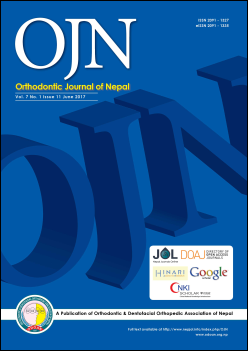Evaluation of Smile Line in Natural and Forced Smile Position: An Institution-based Study
DOI:
https://doi.org/10.3126/ojn.v7i1.18898Keywords:
esthetics, periodontium, smile, smile lineAbstract
Introduction: Smile line is a major factor considered in esthetic treatment planning.
Objective: To assess the position of the smile line both in natural and forced position in relation to age and gender in Nepali population sample.
Materials & Method: A cross sectional study was done in 220 adults. DSLR camera was used to take photograph of the participants. Two different photographs were taken of each participant in natural and forced smile position in standardized format. The smile lines were determined and classified according to Liebart et al. Data analysis was done by SPSS 20.0 software. Chi square test was performed to analyze statistical significance between the gender and age groups
Result: Maximum individuals had low type of natural smile (59.1%) and average type of forced smile (40.0%). Very few individuals had very high type of natural smile (1.4%) and very high type of forced smile (15.9%). Among all, 41% had visibility of the periodontium during normal smile while on forced smile 79.1% had visibility of the periodontium.
Conclusion: Females have significantly more periodontal visibility when compared to males during forced smile in Nepali population sample. This concept of smile line should be utilized for treatment planning to achieve desirable facial esthetics in many fields of dentistry including Orthodontics, Prosthodontics, Periodontics, Restorative Dentistry.
Downloads
Downloads
Published
How to Cite
Issue
Section
License
Copyright © held by Orthodontic & Dentofacial Orthopedic Association of Nepal
- Copyright on any research article is transferred in full to the Orthodontic & Dentofacial Orthopedic Association of Nepal upon publication in the journal. The copyright transfer includes the right to reproduce and distribute the article in any form of reproduction (printing, electronic media or any other form).
- Articles in the Orthodontic Journal of Nepal are Open Access articles published under the Creative Commons CC BY License (https://creativecommons.org/licenses/by/4.0/)
- This license permits use, distribution and reproduction in any medium, provided the original work is properly cited.




